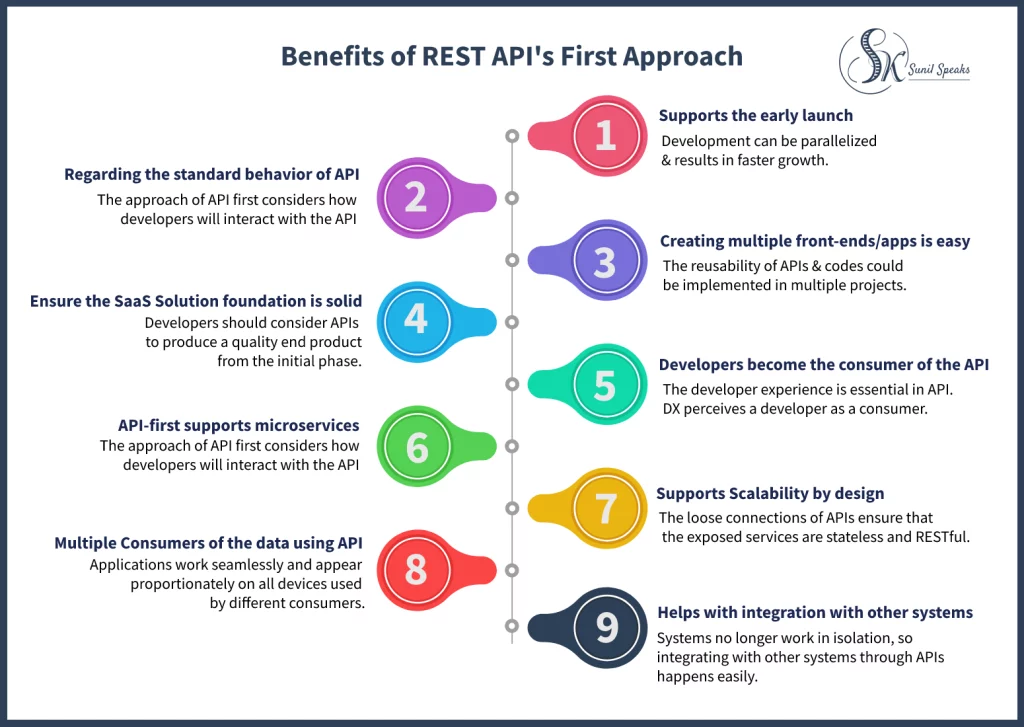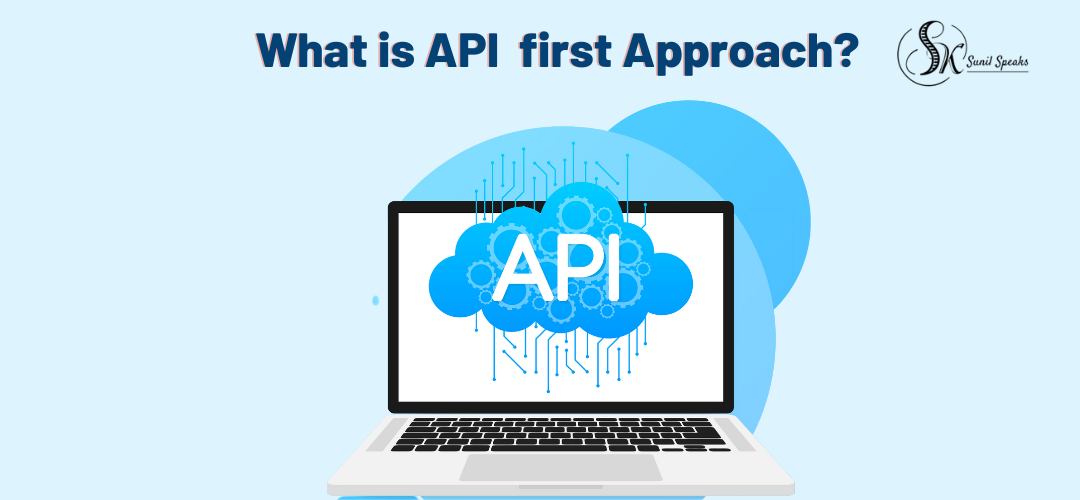There have been many ways to build software in the last few decades, from RAD (Rapid Application Development ) to SOA and microservices. With cloud gaining popularity and reachable to smaller to medium size companies, Software As A Service (SaaS) Solutions are the de facto way today to develop products.
The conventional code-first approach to software development led the field Until recently. But in contemporary times, organizations are migrating to the cloud and availing of Cloud services. Henceforth, an API-first approach came forward.
API first approach is an effective, proven way that adds more flexibility and gives flexibility to the development process; this also supports the reactive event-driven programming model.
An API-first approach means that your APIs are treated as “first-class citizens for any development project.“
All the crucial elements and core ideas of development projects are focused on the thought that the final product will be consumed by applications (internal or external), mobile devices and other systems integrations. They all will consume the APIs.
Regarding the standard behavior of API
Publishing the Application Programming Interface is easy. It is a product that’s complex to prepare for consumption by the public.
Henceforth, it’s the difference between the mere creation of APIs and APIs as Products.
The approach of API first requires thinking about the way that developers will interact with the API and the way you will inform them about the functionality of the API, its maintenance over a period of time, the selection of tools to build the API, and finally the adherence to compatibility, simplicity and security standards.
The newly built products must comply with the industry standards and requirements. By doing this, the practice of using the fundamental principles of software design and development cycles for APIs is used, and the delivery of the end quality product is ensured.
Ensure the SaaS Solution foundation is solid
API first approach from the initial stage requires developers to consider APIs from the initial phase. However, software companies try to adopt an API-first approach after the completion of the end product. i.e., adding the API on top of an existing platform. This approach is beneficial to increase automation and increases functionality that is underlying. However, it is not an API-first approach.
API-first development approach considers APIs as the base. Instead of pre-built software and solutions, the APIs approach ensures that an all-encompassing platform’s functionality is fully accessible through the use of APIs.
API-first supports microservices
APIs facilitate companies to break down capabilities into individual and autonomous services, i.e., microservices. Adopting the approach of building mobile and web applications based on microservices ensures a smooth user experience on all devices.
The development world is considerably driving towards Reusability. Software development companies are transiting from all platforms towards reusable components.
For example, online retailers prefer to procure the best reusable features like inventory management, checkout, payment gateway, order fulfillment, etc., and combine them to create a business product tailored to their needs rather than opting for an e-commerce platform.
The components need to communicate. Adopting an API-first approach to building ensures easy integration of APIS into the microservice architecture and appications by the developers.
Multiple Consumers of the data using API
In contemporary times, data is consumed by both humans and machines. Data through applications are consumed by humans by using many devices like laptops, desktops, tablets, and smartphones with varied screen sizes. So applications built must work seamlessly and appear proportionately suitable on all devices.
Development can be parallelized hence supporting the early launch.
API first involves establishing a contract. Creating a contract between services that are followed by teams across an organization allows those teams to work on multiple parts of the system being developed simultaneously.
The following API can be adopted by a developer without waiting for a new update and release of the API. They can mock and test API dependencies on the premise of the established API definition.
So, designing with APIs ensures a solid foundation for your product. Due to this, the development team can focus on the product’s IT infrastructure in early iterations. It doesn’t imply that one will miss precious time building this framework. APIs can be developed and tested simultaneously. Teammates can work in parallel, which means real-time collaboration and faster feedback cycles. As a result, APIs are quickly designed, implemented, and documented before the channels that use them are set up.
Creating multiple front-ends/apps is easy.
Reusability of APIs and codes could be implemented in multiple projects. A development team, when initiating building a new application, doesn’t have to start from scratch. This saves time and is economical.
Today, businesses need to have multiple front-ends for the consumers. The end-consumer might be using mobile app, whereas internal users are working on the web-based interfaces. The integration with other systems might be API based. All of these scenarios become easy to manage when API first approach is taken where APIs are the core products.
Most problems in API first design are solved before even writing the code as contracts are first laid down so ensure APIs do what they are meant to; this evades issues when integrating APIs with applications.

Developers become the consumer of the API
It is essential to prioritize the developer experience when developing an API. DX perceives a developer as a consumer, an intermediary, or an end-user of a product (of an API). This renders developers a vital element of the value delivery chain. They create APIs and leverage them for the consumer’s and business’s benefit.
An API-first approach is about APIs being more like the product and less like the technology. Thus, it makes sense to have an API that is functional and easily usable by developers. The goal of an API is to create a rich ecosystem where developers can effortlessly get some information and create applications on top of it. Designing API first helps internally structure the IT system and architecture developers use to build applications. So, by defining APIs first, you automatically prioritize developer experience, as API availability from the outset is a way to boost efficiency and speed of innovation.
Supports Scalability by design
The loose connections of APIs ensure that the services they expose are as stateless and RESTful as possible. REST APIs allow for “loose” connections while minimizing or eliminating dependencies. This supports scalability because it’s easier to deploy, replicate, and destroy instances of a specific microservices app component in response to fluctuating demands on the system.
Helps with integration with other systems easily.
Sooner or later (I hope sooner), the SaaS solution needs to expand and integrate. Having API first from the beginning lets you move quickly.
There is a greater and greater need to have connected systems today. The user is demanding, and isolated systems do not serve the requirements. Additionally, within an organization, the data lives in diverse systems that need to be Integrated.
As systems no longer work in isolation, integrating with other systems through APIs will happen. The team already having experience with APIs will help in the integrations also.
In Summary
Computer Scientist Roy Fielding formulated REST and Its principles in the year 2000, and they are becoming the de facto standard of catering to the complex needs of today’s software development. They are omnipresent and are the first choice for development, integration between systems, etc.
APIs play a pivotal role in developing mobile and web applications, cloud-based apps, and automated customized business solutions. REST APIs have extensive usage in all the domains mentioned above. It is continuously evolving, and its application is also growing extensively.

